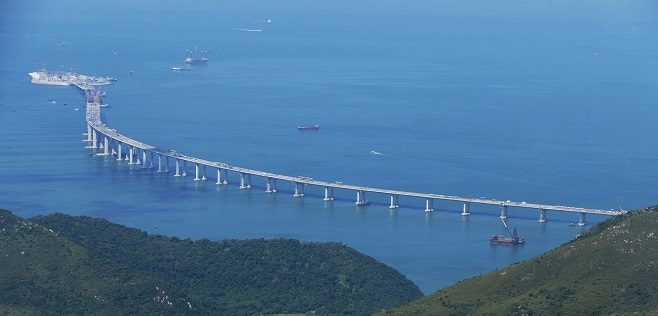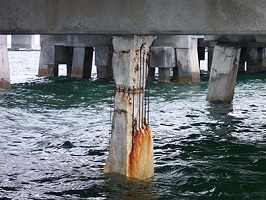
A Vanderbilt civil engineering professor is a key investigator in a new international project to revolutionize production of concrete using seawater, sea sand and fiber-reinforced polymer composites.
The Hong Kong Research Grants Council, which is equivalent to the U.S. National Science Foundation, has awarded a $6.7 million, five-year grant to a multi-university team of experts in materials science, chemistry, civil engineering, material deterioration, complex modeling, and other specialties.
Florence Sanchez, associate professor of civil and environmental engineering at Vanderbilt School of Engineering, is a co-Principal Investigator – one of nine and the only one who is not Chinese – and an expert in molecular dynamics simulation of composite materials. In all, about two dozen specialists from eight countries are involved.

The impact could be huge – concrete is the second most-used substance in the world, behind water. Concrete production is resource-heavy, both in raw materials and costs to transport them. Fresh water and river sand or crushed stone fines already are scarce in marine, island and coastal communities, where the steel used to reinforce traditional concrete erodes more quickly.
“This has huge implications,” Sanchez said.
The key challenge for the researchers is to understand and predict the life-cycle behavior of structures made from seawater-sea salt concrete and fiber-reinforced polymer composites, or FRPs. They also will develop a life-cycle design methodology based on multi-scale physics modeling of material and structure degradation that includes accelerated lab tests in controlled environments and field exposure tests over a limited period.
“This project combines structural engineering with materials science and applied research and fundamental science,” said Sanchez, who is deputy leader for one of five primary research areas – material deterioration and constitutive modeling.
Specifically, she will investigate how the materials react with each other and their target environments at the molecular level. Of particular interest are chemical, mechanical, and environmental interactions at interfaces of the new concrete components with each other and the FRP that will replace traditional steel re-bar as reinforcement.
“This project is about getting that fundamental understanding,” said Sanchez, who was on the five-person team that participated in the final interview process in Hong Kong in June. “It is a new, exciting collaboration.”
The five-year effort creates opportunities for graduate student and faculty exchanges, too.
Steel corrosion is the main cause of marine infrastructure deterioration and is estimated to cost an economy 3 percent of its annual GDP. For Hong Kong, 3 percent of its GDP is about $10 billion. In 2013, the U.S., the American Society of Civil Engineers estimated it would cost $3.6 trillion to repair U.S. infrastructure from 2013 to 2020.

The project is vital for Hong Kong, which, like other coastal cities, relies heavily on concrete ports, bridges, artificial islands, offshore wind farms, and housing, for socio-economic development.
The supply of fresh water and sand is not infinite. Rapidly growing middle classes in countries such as India and China and economic development across the globe have created pressure to find methods and materials that are more sustainable than classic concrete.
The need for alternatives is clear. Experts estimate that more than half the world’s population will lack sufficient freshwater by 2025, and the construction industry uses more than 1 billion tons of potable water each year in concrete production.
Some projects have used seawater but not in combination with FRPs. These highly durable composites do not corrode, though they do slowly deteriorate in aggressive environments. The life-cycle cost of fiber-reinforced polymer composites may be half the cost of steel reinforcement, and FRP is predicted to retain 75 percent of its strength after 100 years, according to the research proposal.
Concrete, which has been relatively inexpensive to produce, is easy to take for granted. It’s everywhere – sidewalks, roads, housing, office towers, bridges, ports, levees, shopping centers, parking garages, curbs, and suburban driveways.
“We walk on it. We are surrounded by it but we don’t see it,” Sanchez said.
“Without this we wouldn’t have infrastructure,” she said, adding that a small change to the components has significant repercussions. “It is probably one of the most complex materials that exist and one of the best to study.”
The new project includes researchers from Hong Kong Polytechnic University, the lead institution; Hong Kong University of Science and Technology; Fourth Harbour Engineering Institute, China; the University of Macau; City University of London; Ghent University, Belgium; École polytechnique fédérale de Lausanne (EPFL), Switzerland; The University of Tokyo, Delft University of Technology, The Netherlands; and, in the U.S., MIT, the University of Illinois–Urbana-Champaign and University of Miami, in addition to Vanderbilt.
Media Inquiries:
Pamela Coyle, (615) 343-5495
Pam.Coyle@Vanderbilt.edu
Twitter @VUEngineering